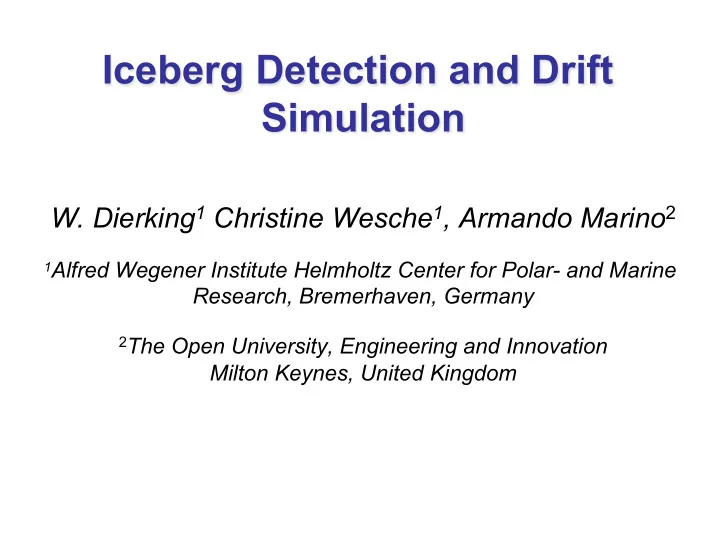

Iceberg Detection and Drift Simulation W. Dierking 1 Christine Wesche 1 , Armando Marino 2 1 Alfred Wegener Institute Helmholtz Center for Polar- and Marine Research, Bremerhaven, Germany 2 The Open University, Engineering and Innovation Milton Keynes, United Kingdom
Problems? - SAR images: • detection of small icebergs (Titanic: 15-30 m freeboard, 60-120 m length) • detection of icebergs in deformed sea ice - Iceberg drift forecasting Motivation for drift forecasting • marine safety • limit search area for new iceberg position in satellite images • reduce ambiguities in identifying particular bergs
Detection: Thresholding WESCHE, C. and W. DIERKING, "Iceberg signatures and detection in SAR images in two test regions of the Weddell Sea, Antarctica". Journal of Glaciology. 2012, vol 58 (208), p. 325-339 • single-polarized images icebergs & sea ice ERS-2 & Envisat ASAR 25 m pixel • icebergs in open water and in sea ice • success of detection icebergs & sea ice is determined by 150 m pixel pre-processing • dependence of thresholds on wind/ice „dark“ icebergs conditions & open water 30 m pixel • problems in deformed sea ice
Detection: Quad-Pol. Data Dierking, W., Wesche, C. (2014), ”C-Band radar polarimetry – useful for detection of icebergs in sea ice?”, IEEE Transactions on Geoscience and Remote Sensing , Vol. 52, No. 1, 25-37 Use of polarimetric parameters improves discrimination between icebergs and sea ice only in some cases!
Detection: Dual-pol incoherent Data Marino, A., Rulli, R., Wesche, C., Hajnsek, I. (2015) “A New Algorithm For Iceberg Detection With Dual-polarimetric SAR Data” Proc. IGARSS 2015, Milan, Italy. • icebergs present an enhanced volume scattering compared to sea ice and ocean surface (dual-pol. analysis) • new detector focuses at anomalies/increases of volume scattering. • Specifically the detector will be higher than 1 if there is an increase in HV intensity and depolarisation ratio . Both are indicators of volume scattering.
Detection: Dual-pol incoherent Data Sentinel-1 EW HH HV (05/04/2015). East Greenland (Fram Strait) Window used: Test = 3x3; Train = 101x101. HV Magnitude Volume Anomaly Mask CA-CFAR HV Enhanced Magnitude
Iceberg Calving: Monitoring Source Locations Wesche, C., Jansen, D., and Dierking, W. (2013) , “Calving fronts of Antarctica: Mapping and Classification”, Remote Sens. 2013, 5 (12) pp. 6305-6322 Ice stream (IS) pattern Surface structure of calving sites determines dominant iceberg shapes and sizes.
Iceberg Calving: Monitoring Sites Antarctica three different calving site surface structures: C1 – parallel C2 – orthogonal C3 – IS C4 – no crevasses C5 – grounded ice
Drift Simulation: Test of a simple model CRÉPON, M., HOUSSAIS, M. N. and SAINT GUILY, B. "The drift of icebergs under wind action". Journal of Geophysical Research. 1988, vol 93 (C4), p. 3608-3612. • Forces to be considered: air & ocean drag, water pressure gradient, Coriolis force, wave radiation or sea ice stress • mixed layer: wind drag • layer below: geostrophic => velocity proportional surface slope
Drift Simulation: Input Data “literature”, typical values • densities ice, water, air • drag coefficients: air-water, air-ice, ocean-ice, tangential air-ice + ocean-ice • mixed layer depth • wind speed and direction (NCEP Reanalysis) “from the field” • iceberg dimensions (assuming a cuboid) lengths 370 – 7000 m widths 100 – 4000 m heights 116 – 304 m • iceberg starting position
Drift Observations & Test Sites Drift patterns were retrieved from position data of GPS- buoys on 11 icebergs in different regions: Southern Weddell Sea SWS (model modifications) SIC ≈ 100%, SIT ≈ 1.0-1.5 m; Weddel Gyre Eastern Weddell Sea EWS SIC < 10%, SIT < 0.5 m; Coastal Current (->west) North Eastern Weddell Sea NEWS SIC = 0%, ACC
Drift Simulation: Results <=> Observations WESCHE&DIERKING, Estimating iceberg paths using a wind-driven drift model, 2015, submitted manuscript Different test sites Differences of drift angles and magnitudes after 5 days
Drift Simulation: Results <=> Observations 5-days iceberg paths “Forecasts” would be acceptable for guiding image positioning (wide-swath scenario)
Drift Simulation: Results <=> Observations Why differences? • simplifications of the drift model used (local ocean currents are not considered, idealized mixed layer=> Ekman spiral) • coarse spatial and temporal resolution of forcing data (example: near-coast: influence of topography on local wind patterns) • influence of iceberg shape not adequately considered (assumption: iceberg shape = cuboid) • (tests with more complex models do not reveal significantly better results!)
Interesting study => “operational on-site” I. D. Turnbull, N. Fournier, M. Stolwijk, T. Fosnaes, D. McGonigal, Operational iceberg drift forecasting in Northwest Greenland, Cold Regions Science and Technology 110, 1-18, 2015 • support of coring campaign, NW Greenland • operational model, near real-time input of metocean parameters, iceberg drift and size, tidal currents, weather forecast • estimation of air and water form drag by matching observed and hindcast iceberg trajectories
Conclusions • Iceberg monitoring over larger regions should include observations of calving sites + drift forecasting • Iceberg drift models: more complex ones do not necessarily deliver more accurate data! • Largest problem of forecasts of iceberg drift: in most cases input parameters cannot be provided with required accuracy • Local (“on-site”) operational monitoring possible with more or less detailed information about input parameters (high logistical effort)
Recommend
More recommend